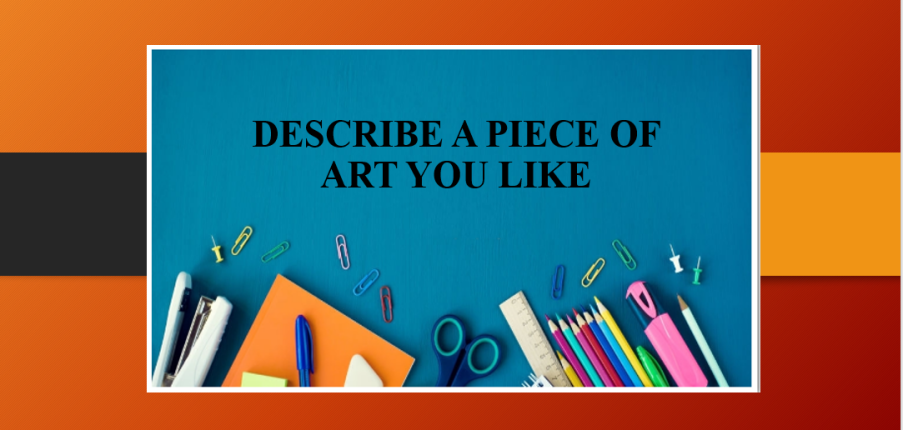Describe a piece of art you like | Bài mẫu IELTS Speaking part 2, 3
Bài mẫu IELTS Speaking Part 2: Describe a piece of art you like
Bài mẫu 1 + Từ vựng
Bài mẫu
Since I love art so much, I’ve visited a ton of galleries in the past. Regarding this subject, I would discuss the Louvre Museum picture that particularly affected me. It was the day my family and I spent the entire day at the Louvre Museum in Paris.
The Mona Lisa, also known as the Portrait of Lisa Gherardini, is an outstanding oil painting by Leonardo da Vinci that dates to, I believe, the 16th century. It is regarded as a symbol of the Italian Renaissance and one of the most well-known paintings in the entire world.
This picture is one of my favorites because it displays Leonardo’s mastery of sfumato (the use of fine shading), as well as his awareness of the musculature and the skull beneath the skin.
The three-quarter view immediately established itself as the standard for all portraits and persisted through the twenty-first century. It broke from the traditional profile attitude used in Italian painting and shifted the sitter’s posture primarily toward the viewer.
The Mona Lisa’s landscapes are also particularly noteworthy since they serve as a visual representation of the concept of ecstasy. The middle distance, which is level with the sitter’s chest, is represented by warm colors. I could spend all day gazing at this, as I do with many excellent paintings.
Từ vựng:
- Outstanding (adj): nổi bật
- Italian Renaissance (n): thời phục hưng của Ý
- Sfumato (n): kỹ thuật đổ bóng
- Fine shading: che bóng tốt
- Musculature (n): cơ bắp
- The skull beneath the skin: hộp sọ bên dưới da
- Portraits (n): chân dung
- Persist (v): kiên trì
- The sitter’s posture (n): tư thế của người trông trẻ
- Ecstasy (n): thuốc lắc
- The sitter’s chest (n): ngực của người trông trẻ
Bài mẫu 2 + Từ vựng
Dàn bài
Ý tưởng bài mẫu (tiếng Việt)
- Đề bài Describe a piece of art you like yêu cầu thí sinh miêu tả một tác phẩm nghệ thuật bạn yêu thích, trong đó cần đưa ra những thông tin:
-
- Tác phẩm đó là gì
- Bạn thấy nó khi nào, ở đâu
- Trông nó như thế nào
- Giải thích lý do tại sao bạn lại thích nó
- Đề bài Describe a piece of art you like thuộc chủ đề lớn là Favorites. Để xử lý đề bài Describe a piece of art you like, cách dễ dàng và hiệu quả nhất đó chính là bám sát những các cue (gợi ý) mà đề đưa ra và cung cấp thông tin rõ ràng nhất có thể, hạn chế nói chung chung.
- Với câu hỏi đầu tiên trong đề bài Describe a piece of art you like, tác phẩm đó là gì. Câu hỏi này nhìn chung thì khá dễ để trả lời, bởi chúng ta đều đã biết mình yêu thích tác phẩm nào. Hãy chọn cho mình một tác phẩm nghệ thuật mà mình thực sự yêu thích và có nhiều điều chia sẻ. Đó có thể là một tác phẩm điêu khắc, một bức tranh…
- Tiếp đó, chúng ta cần đi vào chi tiết hơn với câu hỏi số hai trong bài Describe a piece of art you like, bạn thấy nó ở đâu, khi nào. Lúc này, ta sẽ bắt đầu đưa bối cảnh mà ta nhìn thấy tác phẩm đấy.
- Nối tiếp luận điểm này trong bài Describe a piece of art you like, các bạn có thể trả lời câu hỏi thứ ba, trông nó như thế nào. Ở ý này, chúng ta có thể nói cụ thể hơn về các chi tiết cụ thể về tác phẩm nghệ thuật đấy.
- Cuối cùng nhưng lại là phần quan trọng nhất của đề bài, chúng ta cần đi giải thích lý do chúng ta lại thích nó. Các bạn thí sinh nên dành phần nhiều thời gian cho câu hỏi này, bởi nó là nội dung chính của đề bài. Để trả lời một cách rõ ràng, mạch lạc và đúng trọng tâm yêu cầu của đề bài Describe a piece of art you like.
Take-note trong 1 phút (tiếng Anh)
|
What the piece of art is
|
- A painting named Little Thuy, painted by the legendary Tran Van Can
|
|
Where and when you saw it
|
- A few months ago, when I strolled around Vietnam National Fine Arts museum
|
|
What it looks like or what it shows
|
- The portrait of the eight-year-old grand-daughter of the artist
- Big round black eyes, plump lips, chubby cheeks, sitting on the chair with hands closed and eyes looking directly at the viewers.
|
|
Why you like it
|
- Interesting background information
- The expression and the pose of the girl reflects the image of Vietnamese society before the August Revolution
- Harmonious color combination
=> Still remember vividly every single detail and would love a chance to go back to enjoy its beauty in person once again.
|
Bài mẫu
Being an art aficionado, I take a fancy to visiting art galleries. In fact, I’ve had the chance to see ample pieces of art, but the one that really stands out to me is Little Thuy, a so-called national treasure, painted by the legendary Tran Van Can, a renowned Vietnamese artist back in the twentieth century.
I came across this masterpiece when I strolled around the Vietnam National Fine Arts Museum in Hanoi a few months ago, and I was in love with it right at first sight. It was the portrait of a real person named Thúy, the eight-year-old grand-daughter of the artist. With big round black eyes, plump lips, chubby cheeks, she sits on a chair with her hands closed, slightly leaning and looking a little shy with a light curtain decorated with bright flowers in the back. Contrary to her overall timid appearance are her innocent black eyes looking directly at the viewers.
This work intrigued me, especially when I read the description on its side. It has been claimed by some art critics that the expression and the pose of the girl pretty much reflects the image of Vietnamese society before the August Revolution, immersed in westernization.
Another thing that made me find it hard to take my eyes off of it is the harmonious color combination. The light-colored clothes of the girl, the pale yellow wall as well as the brown chair go really well with one another. Since the piece was meticulously painted in oil with western techniques and materials, the color palette looks even more brilliant.
It has been a few months, yet I still remember vividly every single detail of this masterpiece. Hopefully, I can arrange my time to go back to the museum to admire its beauty in person.
Từ vựng:
- Art aficionado: tín đồ yêu nghệ thuật
- Take a fancy to V-ing: thích làm gì
- At first sight: ngay từ cái nhìn đầu tiên
- Westernization (n) phương Tây hóa
- Take one’s eyes off something: rời mắt khỏi cái gì
- Go well with: hòa hợp với
Bài mẫu IELTS Speaking Part 3: Describe a piece of art you like
Describe the general purpose of art. And say why do people enjoy art?
My modest opinion is that art is a kind of self-expression that enables us to express ideas and thoughts that are difficult to explain verbally. They can be incorporated into writings, images, music, or any other medium that will best help the artists’ message get over. People enjoy art, probably because it allows them to escape from the stresses of everyday life.
As soon as they immerse themselves in the art, their emotions may shift, and it’s likely that they will forget about their problems in favor of fully appreciating the beauty of the work. In addition, there are many parts of art that people are unable to experience in their daily life, making it a wonderful opportunity to view the world from a variety of angles.
- Modest (adj): khiêm tốn
- Self-expression (n): sự thể hiện bản thân
- Verbally (adv): bằng lời nói
- Be incorporated into: được đưa vào
- Get over (v): vượt qua
- Immerse oneself in (v): đắm mình trong
Do you think that art is as important as academic subjects when it comes to educating children?
Sure. It has been asserted that children’s creativity, which is essential to their development as adults, can be fostered through the medium of art. Art encourages youngsters to think creatively, whereas academic topics appear to just emphasize critical and logical thinking. Therefore, the inclusion of art in the curriculum is crucial for the total development of the individual. The fact that art-related courses are less demanding than academic ones ensures that children can maintain a balance in their emotions and general well-being.
- Curriculum (n): chương trình giảng dạy
What are the advantages and disadvantages of art education?
Pros and cons both exist for art instruction. On the one hand, it is important to keep in mind that learning the arts may be expensive because it costs a lot of money to buy the materials and equipment required for the entire learning process. On the other hand, as was already mentioned, art is unquestionably crucial to our personal growth since it can inspire creativity, which in turn stimulates the right side of our brain and enables us to think and act in innovative ways.
Additionally, it serves as a means of self-expression by enabling us to let everything out. As a result, it is essential that schools view the funds spent on art instruction as an investment in their students’ future.
- Pros and cons (n): ưu – nhược điểm
- Innovative (adj): đổi mới
Xem thêm các tài liệu Tiếng Anh hay, chi tiết khác:
TOP Việc làm "HOT" dành cho sinh viên:



